16-Year-Old Guest Blogger Samuel Talks Sustainable Building
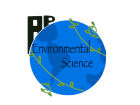
Many of you at St. Margaret’s Church know the energetic Samuel Enriquez. He’s a high-school-aged teen who’s being home-schooled and taking some courses at Anne Arundel Community College. Latin and calculus are among his current subjects. His environmental science course offers the option of learning about a “real-world” application in his community in lieu of the AP exam.
His learning encompasses sustainable building design and construction, and how the LEED rating system helps inform the strategies of high-performance, “healthy” buildings. I have the privilege of guiding this fine young man who is very inquisitive and quick of mind. In one particular “real-world” application, Samuel and I met in the on-site construction trailer one afternoon with the Project Engineer of GC Whiting-Turner to discuss the LEED program particular to St. Margaret’s. Hard hats, safety vests, metal folding chairs, coffee pots, plans and specifications and building samples–all there.
Here’s Samuel’s first guest post (written and illustrated by him, of course)…
“L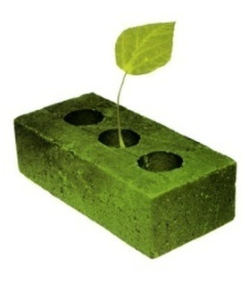 EED – Minimizing The Church’s Environmental Impact” – by Samuel Enriquez
EED – Minimizing The Church’s Environmental Impact” – by Samuel Enriquez
Here at St. Margaret’s, we’ve been hearing a lot about the new formation building and getting LEED certification for it. And you probably know why getting the certification is important – it shows that both the construction process and the building itself are environmentally friendly. But what you might not know is how we are earning the certification, and how we’re minimizing the building’s impact on the environment. Both the construction process and the design of the building itself contribute to lessened environmental impact.
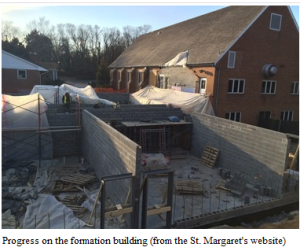 In the construction process, we are both using environmentally friendly materials and using them responsibly. To reduce heating costs, we are using EPDM bonded sheet roofing (a white, rubberlike polymer) and fiberglass-asphalt roofing tiles, both of which reflect light and heat away from the
In the construction process, we are both using environmentally friendly materials and using them responsibly. To reduce heating costs, we are using EPDM bonded sheet roofing (a white, rubberlike polymer) and fiberglass-asphalt roofing tiles, both of which reflect light and heat away from the 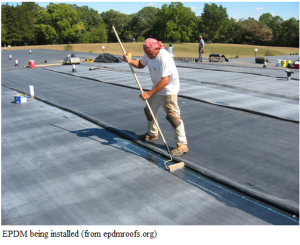 building due to their light coloring. We are also using low-emission paints and sealants to cut down on the number of hazardous chemicals. However, some indoor air will inevitably be contaminated, not just with chemicals but also with dust stirred up by construction, so the indoor air will be flushed out before the building is occupied.
building due to their light coloring. We are also using low-emission paints and sealants to cut down on the number of hazardous chemicals. However, some indoor air will inevitably be contaminated, not just with chemicals but also with dust stirred up by construction, so the indoor air will be flushed out before the building is occupied.
We’re also going to document that at least 75%, and hopefully 90% or more, of the solid and liquid waste generated in construction is disposed of responsibly. Additionally, we are attempting to source some of the building material from regional manufacturers. We definitely have carpeting, and we are hoping to obtain some regional concrete, drywall, and insulation as well.
The building’s design has also been chosen to minimize impact on the environment in energy and water use. We will have a 2-year contract with 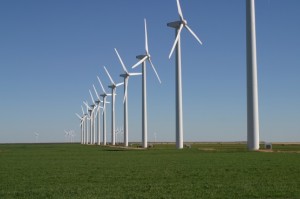 Constellation New Energy Inc. or like company to power the new building solely through wind energy provided from a national consortium. “Solely through wind energy” does not mean that every watt in the building comes directly from a wind turbine. The BG&E grid draws power from a variety of sources, and the electricity flows from each source are indistinguishable once they enter the grid. What it does mean is that for every watt we use in the building, a watt from the wind energy consortium will enter the grid, so that 100% of the unspecified power we draw from the grid is replenished by wind energy.
Constellation New Energy Inc. or like company to power the new building solely through wind energy provided from a national consortium. “Solely through wind energy” does not mean that every watt in the building comes directly from a wind turbine. The BG&E grid draws power from a variety of sources, and the electricity flows from each source are indistinguishable once they enter the grid. What it does mean is that for every watt we use in the building, a watt from the wind energy consortium will enter the grid, so that 100% of the unspecified power we draw from the grid is replenished by wind energy.
To cut back on water use, we will be installing low-flow toilets like the one in the narthex bathroom, which can reduce water use by up to 40%. And 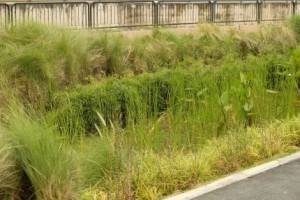 to deal with rainwater from roofs, we are installing an underground stormwater system to filter out particulate runoff. We are also planting a rain garden to absorb groundwater runoff from our old impervious parking lot. These will be planted with sedges and wildflowers native to the Bay area, which will capture water and return it to the soil instead of the sewers. Additionally, we are using grass rather than pavement in the overflow parking areas so rainfall there also goes back into the water table and doesn’t run off the asphalt into the sewer.
to deal with rainwater from roofs, we are installing an underground stormwater system to filter out particulate runoff. We are also planting a rain garden to absorb groundwater runoff from our old impervious parking lot. These will be planted with sedges and wildflowers native to the Bay area, which will capture water and return it to the soil instead of the sewers. Additionally, we are using grass rather than pavement in the overflow parking areas so rainfall there also goes back into the water table and doesn’t run off the asphalt into the sewer.
# # #
Samuel has said he “likes writing about himself in the third person.” Budding novelist, poet, playwright, screenwriter…?